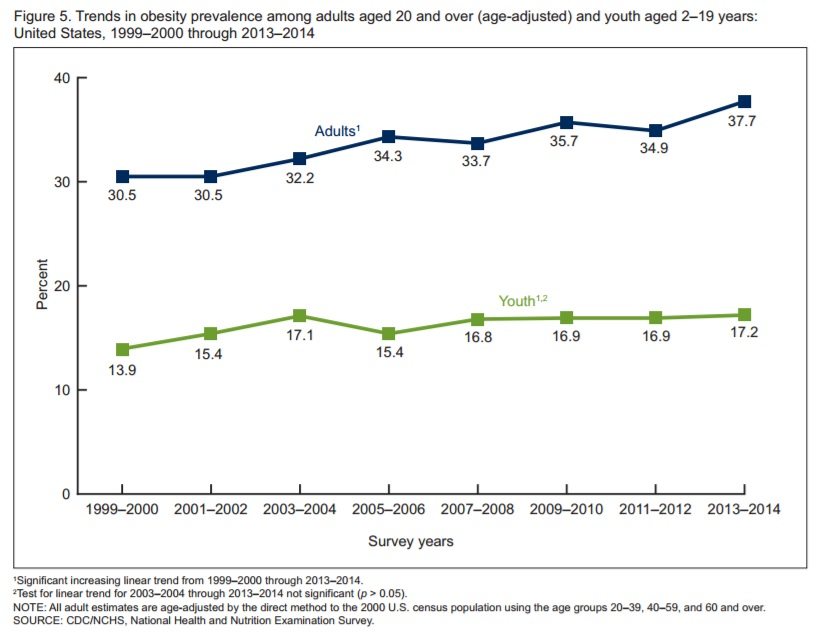 The incidence of overweight and obesity continues to climb in the US, and throughout the world. The most recent statistics from the CDC indicate that, from 2000-2014, obesity in the US increased from 30 to 37% in adults, and 13 to 17% in children.
The incidence of overweight and obesity continues to climb in the US, and throughout the world. The most recent statistics from the CDC indicate that, from 2000-2014, obesity in the US increased from 30 to 37% in adults, and 13 to 17% in children.
A recent NEJM study of obesity worldwide found:
In 2015, a total of 107.7 million children and 603.7 million adults were obese. Since 1980, the prevalence of obesity has doubled in more than 70 countries and has continuously increased in most other countries. Although the prevalence of obesity among children has been lower than that among adults, the rate of increase in childhood obesity in many countries has been greater than the rate of increase in adult obesity. High BMI accounted for 4.0 million deaths globally, nearly 40% of which occurred in persons who were not obese.
Obesity is no longer a problem only of rich industrialized nations, and is increasing in poor nations as well.
Body mass index revisited
Most of the studies use body mass index (BMI) as the measure of overweight and obesity. Like many measures in medicine, BMI is useful but it has its limitations. A recent article in Popular Science repeats the common criticisms of using BMI but doesn’t put those criticisms into context. BMI is a measure of weight in kilograms divided by height in meters squared. It is a rough estimate of adiposity, and is extensively used in epidemiological studies because of convenience. We tend to have height and weight data for large numbers of people.
When applied to large groups, BMI works just fine. When applied to individuals it is more problematic, but still not as bad as its critics would have you believe. For example, in one study researchers compared BMI to a more direct measure of body fat percentage using skin-fold thickness. They found that when subjects met the criterion for obesity based upon BMI, they were truly obese by skin-fold thickness 50-80% of the time (depending on gender and ethnicity). When they were not obese by BMI they were not obese by skin-fold 85-99% of the time.
Accuracy of BMI breaks down at the extremes of height and muscularity. Body builders will have a high BMI because of their extra muscle weight. Meanwhile, a person with an exceptionally thin frame but excess truncal fat might have a normal BMI. The PopSci article points this out as if this would not be obvious to a medical practitioner. In clinical practice BMI supplements an actual physical exam, in which things like girth and muscularity will be obvious. When confronted with an individual patient with an atypical body frame then additional measures like waist circumference and skin fold measures can be used as supplemental data.
All of this is also in addition to metabolic data about an individual patient, like cholesterol, glucose control, and blood pressure. A medical practitioner should put all of this data together in a thoughtful and evidence-based manner to address their patient’s real risks.
In the sports world the situation is a little different. There are indications that coaches and trainers overutilize BMI, which is likely to be less accurate for athletes. This is likely to be coupled with unsafe weight loss practices.
In short, there is no problem specifically with BMI – it is a reasonable and convenient measure that applies well to large populations and can supplement other information about individual patients. There may be a problem with how BMI is used in certain cases, but this too is similar to many measures in science and technology. There is an oversimplification bias in which we substitute a simple question for a more complex question, or a simple measure for a more detailed one. BMI should not be used as the one measure of health or even ideal weight. It needs to be use properly and in the context of other relevant information.
As an analogy, there is nothing specifically wrong with using the p-value to evaluate scientific data in an experiment. The problem comes from simplistically substituting this one number for a more thorough analysis of the data and its implications.
Tackling the epidemic
There is no question at this point that there is an obesity epidemic, the problem is worsening over time, and it is spreading throughout the world. This seems to be an inherent problem with modern civilization. There is an ongoing debate about the relative contributions of a sedentary lifestyle and food abundance, but clearly both play a role.
There is also no question that obesity is an independent health risk factor. According to the NEJM article:
In 2015, high BMI contributed to 4.0 million deaths (95% uncertainty interval, 2.7 to 5.3), which represented 7.1% (95% uncertainty interval, 4.9 to 9.6) of the deaths from any cause; it also contributed to 120 million disability-adjusted life-years (95% uncertainty interval, 84 to 158), which represented 4.9% (95% uncertainty interval, 3.5 to 6.4) of disability-adjusted life-years from any cause among adults globally. A total of 39% of the deaths and 37% of the disability-adjusted life-years that were related to high BMI occurred in persons with a BMI of less than 30.
Excess health risk comes mainly from cardiovascular disease and increased risk of diabetes. Increased risk from obesity may exceed that from smoking. For individuals, extreme obesity (BMI > 45) has a higher mortality than having a healthy BMI and smoking.
Unfortunately, there is no simple solution to this problem. It seems that cultural changes will need to be made, and that is never easy.

